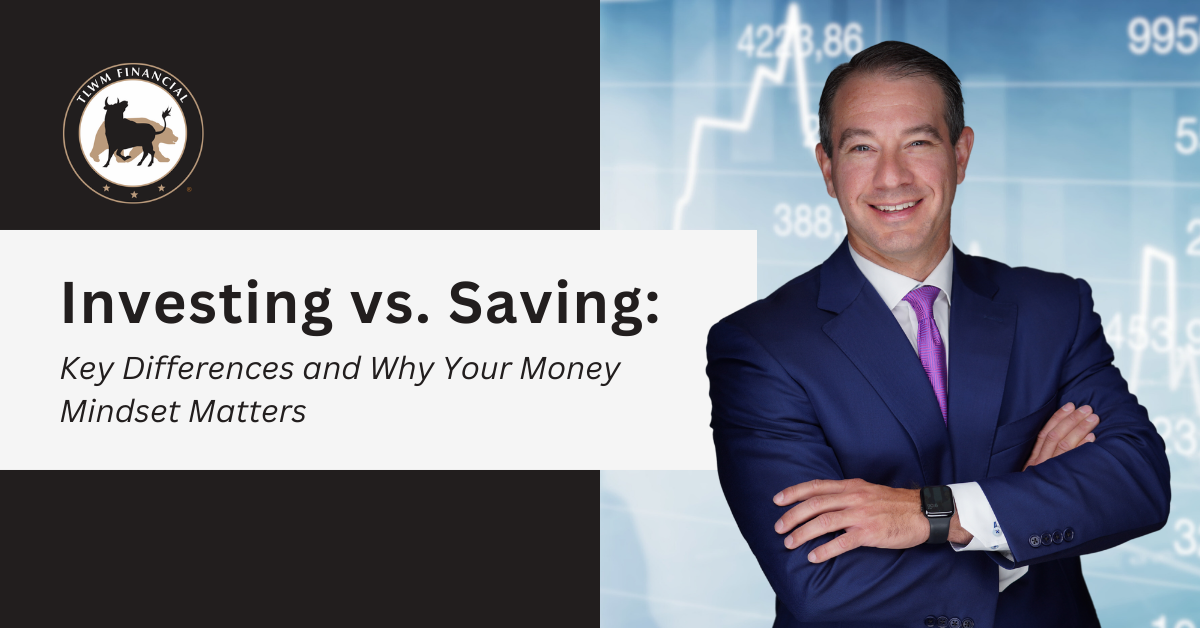Investing vs. Saving: Key Differences and Why Your Money Mindset Matters
Submitted by TLWM Financial on October 10th, 2023
You often hear people discuss "saving for retirement,” but in many cases, they're actually referring to their investing. The adage "you can't save your way to wealth" is simplistic, but has a kernel of truth; putting your money in a savings account often won't be enough to outpace the rate of inflation, which can erode the value of your savings over time. Below, we discuss some of the key differences between investing and saving and how to choose the most optimal course of option for you.
Saving: A Low-Risk Way to Set Aside Funds for the Future
Saving is just a method to set aside money for future use, whether you're putting it into a general "emergency fund" or earmarking it for a new vehicle, a home down payment, or medical expenses. You can keep savings in a checking account, a regular or high-yield savings account, a certificate of deposit (CD), or even certain types of government bonds.
Investing: Putting Your Money to Work for You
Investing, on the other hand, involves putting your money into financial instruments like stocks, bonds, exchange-traded funds (ETFs), and mutual funds. Investing is riskier than saving, but can also earn higher returns over the long term. Even accounting for recessions and depressions, the S&P 500 (composed of the U.S.'s 500 largest companies) has averaged just over 11 percent per year in returns since 19801.
Investing can be one of the most efficient ways to reach your long-term financial goals like paying for a child's college education, purchasing a home, or retiring. For example, if you're saving $100 per week toward your retirement and keeping it in a savings account earning a minimal amount of interest, you'll have about $52,000 in 10 years. If you instead invested this money and achieved an average 10 percent annual rate of return, you'd have around $82,500 in a decade. This is more than a $30,000 increase in value over regular savings2.
Differences Between Saving and Investing
One of the key differences between saving and investing is the security of your funds. Savings is low-risk and low-reward, meaning that over time, you won't earn enough in interest to overcome inflation, but you also won't risk losing your initial funds.
With an investment, you have the opportunity to have a double-digit rate of return over time; but if you're investing in an individual stock and the company goes bankrupt, your funds are gone.
This means it's a good idea to seek some degree of balance. You'll want to keep an emergency fund or any money you expect to use over the next couple of years in a low-risk account, like a savings account or CD. This will ensure the money is there and accessible whenever you need it.
But for longer-term funds, like retirement funds, it can be helpful to try and get ahead of inflation by investing these funds in the stock market. You can invest in whatever you'd like, from conservative bond funds to an aggressive growth portfolio. A financial professional can work with you to assess the best investments based on your risk tolerance, desired asset allocation, and retirement timeline.
Important Disclosures:
The opinions voiced in this material are for general information only and are not intended to provide specific advice or recommendations for any individual. To determine which investment(s) may be appropriate for you, consult your financial professional prior to investing.
Investing involves risks including possible loss of principal. No investment strategy or risk management technique can guarantee return or eliminate risk in all market environments. All indexes are unmanaged and cannot be invested into directly.
Investing in stock includes numerous specific risks including: the fluctuation of dividend, loss of principal and potential illiquidity of the investment in a falling market.
An investment in Exchange Traded Funds (ETF), structured as a mutual fund or unit investment trust, involves the risk of losing money and should be considered as part of an overall program, not a complete investment program. An investment in ETFs involves additional risks such as not diversified, price volatility, competitive industry pressure, international political and economic developments, possible trading halts, and index tracking errors.
Investing in mutual funds involves risk, including possible loss of principal. The funds value will fluctuate with market conditions and may not achieve its investment objective. Upon redemption, the value of fund shares may be worth more or less than their original cost.
Bonds are subject to market and interest rate risk if sold prior to maturity. Bond values will decline as interest rates rise and bonds are subject to availability and change in price.
CD’s are FDIC Insured and offer a fixed rate of return if held to maturity.
S&P 500 Index: The Standard & Poor's (S&P) 500 Index tracks the performance of 500 widely held, large-capitalization US stocks.
All information is believed to be from reliable sources; however, LPL Financial makes no representation as to its completeness or accuracy.
This article was prepared by WriterAccess.
LPL Tracking #1-05376140
Sources:
1 “Stock Market S&P 500 Returns Since 1980,” https://www.officialdata.org/us/stocks/s-p-500/1980
2 “Compound Interest Calculator,” https://www.investor.gov/financial-tools-calculators/calculators/compoun...

